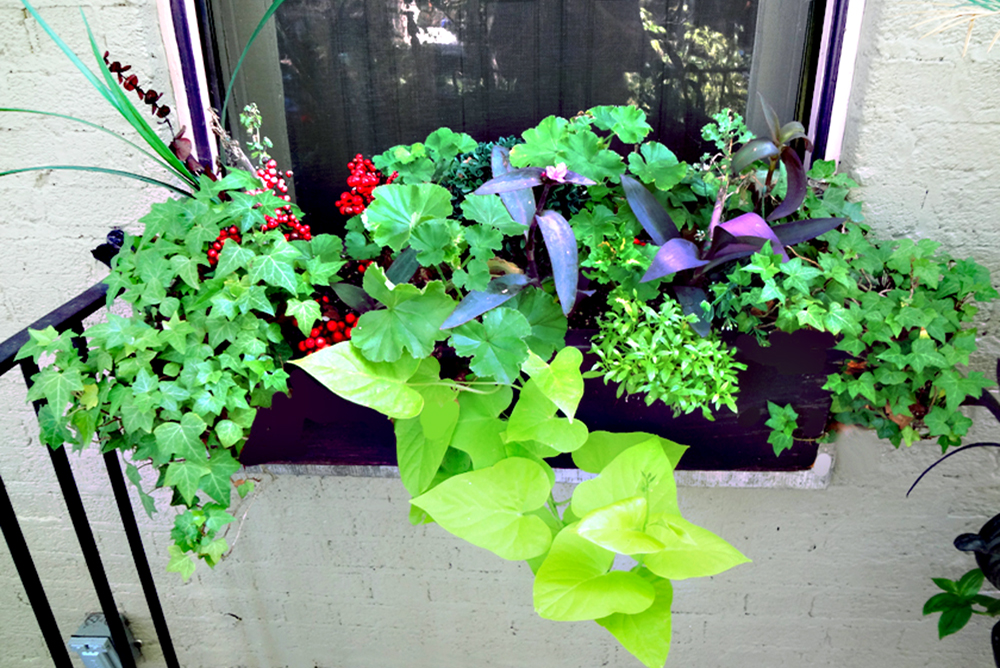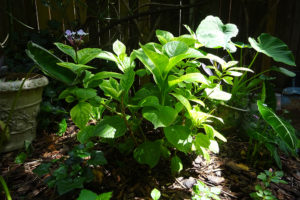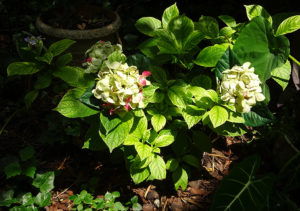
Stephanie Cavanaugh’s window box before the Michael’s treatment. COVER PHOTO: Window box after. Photos by Stephanie Cavanaugh.
PITY MY FORLORN hydrangea, Margot, named for the friend who gifted her to us. She’s eight or 10 or who knows how old now, with one lousy blossom.
This is all the flowering I can expect this summer as the hydrangea sets bud for the following year on the current season’s woody stalks, which they more or less reliably do—unless one’s Prince wanders by with clippers and in a fit of neatness (would that such a fit would take hold in the garage) lops off the buds in September.
Which is precisely what happened last fall.
I was unaware of this tragic happenstance until a sorry dawn in March when I took a somnambulistic perambulation (that was such fun to write) through my garden patch, sleepily observing the this and the that, and noticed the plant’s sharply nipped tips.
Bracing myself for the expected outraged denial, I approached the only possible source of this mishap, and asked if perhaps he’d exceeded the boundaries I’d imposed on his pruning—which was supposed to be confined to the (for me) unreachable. Well. His Irish cheeks reddened and his bald patch began to mist and he insisted . . . that it was the damn squirrels.
Squirrels, said I, do not have teeth like secateurs,* the branches would be nibbled not whacked. And he scurried away muttering something . . .

Sad Margot, the hydrangea, after an untimely pruning. / Photo by Stephanie Cavanaugh.
And so this year we have one flower, which is particularly tragic since we moved Margot last summer—or he did, while I supervised. It was a terrifying feat in Washington’s paralyzing heat. She’d grown so enormous that she could nearly shake hands with Phyllis, another gift, across the path that one might (if one were of a mind to) call the ceremonial approach to the garage.
Margot spent last summer regaining her verve, and was fine and bushy until she was so thoughtlessly violated.

Happy albeit faux Margot, after her Michael’s treatment. / Photo by Stephanie Cavanaugh.
Sighing deeply, in my usual cheery what-will-be-will-be fashion, I off and went to Michael’s, purveyors of largely hideous fake flowers among other craft items. Here was scored a coup of sorts: three reasonably realistic green hydrangea branches at a buck apiece that, when poked among the bush’s branches, appear to have blossomed there.
This is hardly a new trick for me. I’ve been faking things since we moved into the house, beginning (I think) with spray-painting a patch of backyard where Someone sprayed weed killer a few hours before a dinner party, not realizing that there was no grass—just weeds.
I’ve even gone so far as to fake the flowers in the white garden of the Raleigh Arboretum where Baby and her Personal Prince Pete were wed last spring, draping the gazebo and surrounding bushes with branches of Michael’s finest white polyester dogwood and hydrangea blossoms. (Not only did she pick a weekend when there was absolutely nothing in bloom, but it poured on our exquisitely, expensively coifed heads, but that’s another story).
For the past few years I’ve planted fake geraniums in my window boxes.
As you may or may not know, geraniums do not do well in 90-degree weather. They stay green, even flourish in their greenness, but are hard pressed to put out more than a measly flower or two between June and September—at least in the tropical heat that smothers Washington, D.C., each summer.
And so, we make do.
Here we are last July. The five frontal boxes look good, if a little dull, with small-leafed ivy dripping over the sides and green potato vine beginning to cascade down the front, but there’s little of natural color—just pops of purple wandering jew, some no-account coleus and several experiments that are a complete waste of water. My red fauxberries are doing fine, as one would expect of fakes.
Michael’s supplied the following additions: a couple of bunches of pink geraniums, some little purple stuffs, and these pink nubbins. All at 70% off—so for like six bucks, replenishment. Dirt cheap is fine for this sort of job, just look for reasonably natural colors.
The trick to effective fakery is to break the bunches apart so individual florets can be cleverly dropped into appropriate locations—like next to the actual doing-nothing geraniums. Don’t fret the leaves: Rip them off if they’re too tacky, they borrow nicely from whatever’s actually living beside them.
Now step back and ponder the effect. Wine helps to lubricate this process. If you’re like me, you’ll say not enough! and stick in a few more stems. Repeat this process with howevermany boxes you have. Et voilà!
If one were really anal, one would move the flowers about each week as if they’re actually blooming. One, however, is not.
—Stephanie Cavanaugh
Gardener Cavanaugh is working on a book about urban gardening. She’ll be back in this spot next Thursday, writing about . . . something (we just never know!).
*Secateur: A very fine synonym for pruning shears that I just learned that makes me appear extremely knowledgeable.
